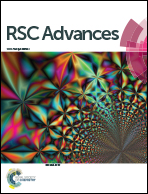A unimolecular DNA fluorescent probe for determination of copper ions based on click chemistry†
Abstract
A homogenous fluorescence method was constructed for Cu2+ detection by employing DNA-templated click chemistry and exonuclease reaction. In this strategy, a dumbbell shaped DNA probe, which contained an alkyne group and an azide group at its ends, was designed as the template for the click chemistry reaction, and also the signal probe. In the absence of Cu2+, the DNA probe was digested into small oligonucleotide fragments by exonuclease, resulting in a low fluorescence background. However, this DNA probe can be sealed at its two ends by Cu2+-induced click chemistry ligation in the presence of Cu2+. This closed structure of DNA would remain stable after addition of exonuclease, and could then be stained by SYBR Green I. A strong fluorescence signal was observed, which was related to the concentration of Cu2+. This assay showed high selectivity and reached the detection limit of 39 nM. Moreover, the proposed strategy exhibited satisfactory detection results in real complex sample analysis, and has promising application in environmental monitoring and food safety.



 Please wait while we load your content...
Please wait while we load your content...